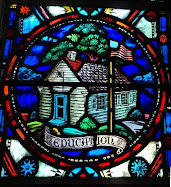“For physical training is of some value,
but godliness has value for all things,
holding promise for both the present life and the life to come.”
1 Timothy 4:8
"Therefore, since we are surrounded by such a great cloud of witnesses,
let us throw off everything that hinders and the sin that so easily entangles,
and let us run with perseverance the race marked out for us.” Hebrews 12:1
The point of fitness is not to tone up any one group of muscles, but to give the whole body strength, vitality, endurance, flexibility, and coordination. If they start an active exercise lifestyle now, they won’t be so tempted to become sedentary adults!
Check with your child’s doctor before starting any strenuous exercise program. He or she will want to rule out any possible problems which might endanger your child. Also, consult your doctor if your child seems unusually tired after an activity, as this could be a symptom of anemia or some other malady.
Aim for a variety of activities to exercise different body systems. Get the lungs breathing (aerobic) and hearts pumping (cardiovascular). Work on coordination and strength for both large and small muscle groups. Examples of well-balanced activities are swimming, fast walking, roller blading, and bike riding.
Don’t forget to warm up before exercise and cool down afterwards. This will help protect your child from cramps, strains, nausea and exhaustion. If you are exercising outside, beware of the symptoms of heat exhaustion!
- practice keeping proper balance during activities
- learn how to fall correctly if you lose your balance
- hop on one or two feet
- skip or run in a straight, curved or zigzag line
- chase or flee (hide and seek, tag)
- jump with one or both feet, perhaps over an object
- jump rope
- dance in rhythm to music
- walk on a balance beam
- do somersaults and cartwheels
- swing by propelling yourself forward and backward using your legs
- climb on a suitable play structure or tree
- go up and down on seesaw
- catch and throw a ball with accuracy
- aim at a target (ring toss, darts, archery)
- hit an object with a hand, club, bat or other object (such as volleyball, badminton, mini-golf, croquet, tennis, T-ball, softball)
- kick a stationary or moving ball
- cross monkey bars hand over hand
- ride a bicycle
- float in water, tread water, use a kick board, swim independently
- hike for an extended distance, using appropriate pace
- follow the rules of a game
- participate in group activities without bumping into others
- lift objects safely
Have fun as a family. Look for activities that you can do at home or in a nearby park. For rainy days, exercise along with a children’s aerobic video in the living room. Kelly-Ann Gritner-Gibbons says, “It is good to develop a family physical activity. The one thing our family does together is go for walks. We have been doing this since our daughter was an infant in a stroller. My husband likes to cycle (I don't!), so he and my daughter bicycle together. If your family plays together, your child is more likely to avoid struggling with inactivity and overweight problems at a later date.”
Make up your own games. Kelly-Ann also says, “The best way to encourage my daughter to exercise is to say “Let's make and play a game together!” We draw a hopscotch outline on the ground with a stick, choose a special marker and play. When we first started to play hopscotch, we began by hopping on both feet (helpful for her aging mama, too). As balance and skill developed, we hopped on one foot. Then we take some turns hopping on the alternate foot in order to develop equal strength and balance. We have also taken plastic pop bottles and made bowling pins. We removed the soda pop label, cleaned and dried the bottles thoroughly. We filled each bottle with 1/4 cup sand, uncooked rice, or cornmeal. We screwed the lid on tightly. When my daughter was three and four, we used a plastic beach ball to roll towards the 'bowling pins.' At five and six years old, she uses a tennis ball.”
If desired, look into group P.E. options. Check to be sure that any group program is suitable for your child, physically, emotionally and socially. Be aware of any time commitments; many team sports require several practices and games per week!
- Enroll in a child fitness program through a community organization or YMCA.
- Join an organized sports league. Upwards is a Christian church-based basketball program that we have found beneficial.
- Organize an informal weekly P.E. / recreation day within your circle of friends, home school group, or church. (Our congregation, which is made up of predominantly home schooling families, hosts an open gym night on Monday evenings.)
Read about fitness and sports. In the children’s section of your library, you will probably find books about playing specific sports, as well as general fitness tips. In addition, you can find biographies of famous sports personalities and teams. This may serve as a motivation for your child to excel.
~*~*~


















